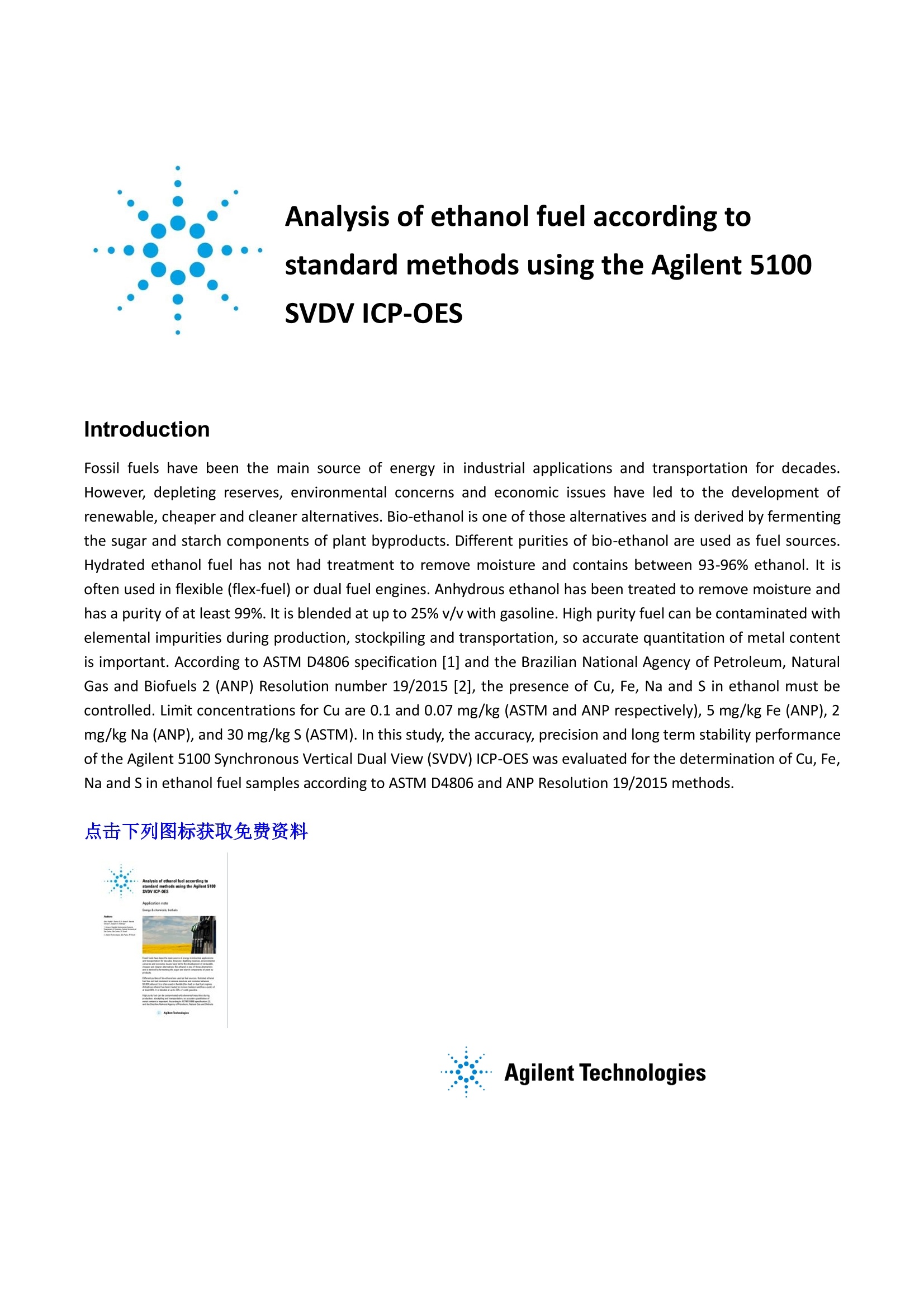
方案详情
文
Fossil fuels have been the main source of energy in industrial applications and transportation for decades. However, depleting reserves, environmental concerns and economic issues have led to the development of renewable, cheaper and cleaner alternatives. Bio-ethanol is one of those alternatives and is derived by fermenting the sugar and starch components of plant byproducts. Different purities of bio-ethanol are used as fuel sources. Hydrated ethanol fuel has not had treatment to remove moisture and contains between 93-96% ethanol. It is often used in flexible (flex-fuel) or dual fuel engines. Anhydrous ethanol has been treated to remove moisture and has a purity of at least 99%. It is blended at up to 25% v/v with gasoline. High purity fuel can be contaminated with elemental impurities during production, stockpiling and transportation, so accurate quantitation of metal content is important. According to ASTM D4806 specification [1] and the Brazilian National Agency of Petroleum, Natural Gas and Biofuels 2 (ANP) Resolution number 19/2015 [2], the presence of Cu, Fe, Na and S in ethanol must be controlled. Limit concentrations for Cu are 0.1 and 0.07 mg/kg (ASTM and ANP respectively), 5 mg/kg Fe (ANP), 2 mg/kg Na (ANP), and 30 mg/kg S (ASTM). In this study, the accuracy, precision and long term stability performance of the Agilent 5100 Synchronous Vertical Dual View (SVDV) ICP-OES was evaluated for the determination of Cu, Fe, Na and S in ethanol fuel samples according to ASTM D4806 and ANP Resolution 19/2015 methods.
方案详情

Analysis of ethanol fuel according tostandard methods using the Agilent 5100 SVDV ICP-OES Introduction Fossil fuels have been the main source of energy in industrial applications and transportation for decades.However, depleting reserves, environmental concerns and economic issues have led to the development ofrenewable, cheaper and cleaner alternatives. Bio-ethanol is one of those alternatives and is derived by fermentingthe sugar and starch components of plant byproducts. Different purities of bio-ethanol are used as fuel sources.Hydrated ethanol fuel has not had treatment to remove moisture and contains between 93-96%ethanol. It isoften used in flexible (flex-fuel) or dual fuel engines. Anhydrous ethanol has been treated to remove moisture andhas a purity of at least 99%. It is blended at up to 25% v/v with gasoline. High purity fuel can be contaminated withelemental impurities during production, stockpiling and transportation, so accurate quantitation of metal contentis important.According to ASTM D4806 specification [1] and the Brazilian National Agency of Petroleum, NaturalGas and Biofuels 2 (ANP) Resolution number 19/2015 [2], the presence of Cu, Fe, Na and S in ethanol must becontrolled. Limit concentrations for Cu are 0.1 and 0.07 mg/kg (ASTM and ANP respectively), 5 mg/kg Fe (ANP), 2mg/kg Na (ANP), and 30 mg/kg S (ASTM). In this study, the accuracy, precision and long term stability performanceof the Agilent 5100 Synchronous Vertical Dual View (SVDV) ICP-OES was evaluated for the determination of Cu, Fe,Na and S in ethanol fuel samples according to ASTM D4806 and ANP Resolution 19/2015 methods. 点击下列图标获取免费资料 · Agilent Technologies
确定

还剩1页未读,是否继续阅读?
安捷伦科技(中国)有限公司为您提供《乙醇燃料中分析检测方案(ICP-AES)》,该方案主要用于生物能源中分析检测,参考标准--,《乙醇燃料中分析检测方案(ICP-AES)》用到的仪器有
相关方案
更多
该厂商其他方案
更多








